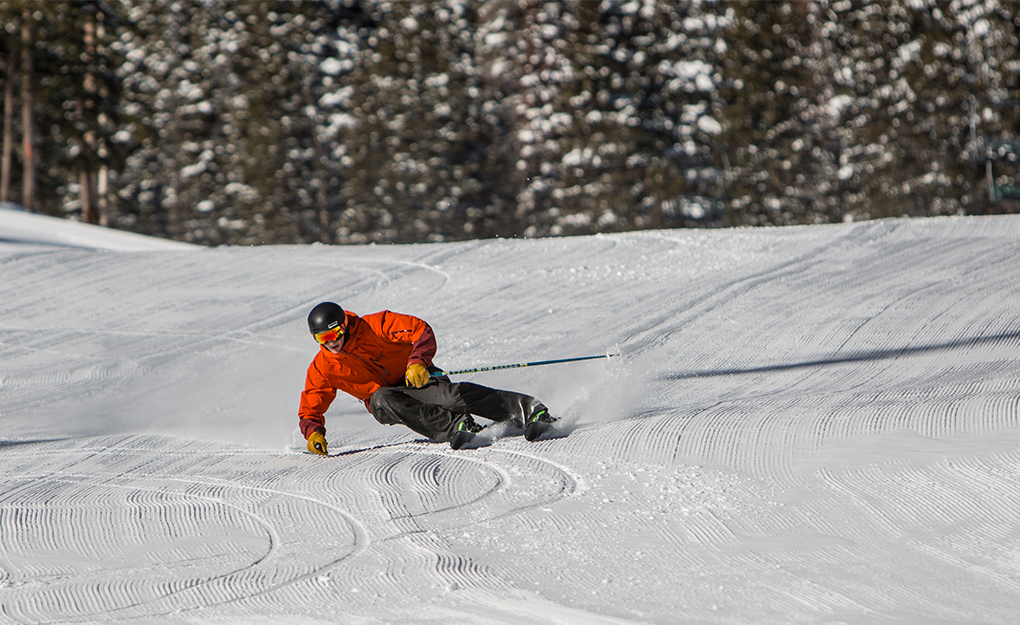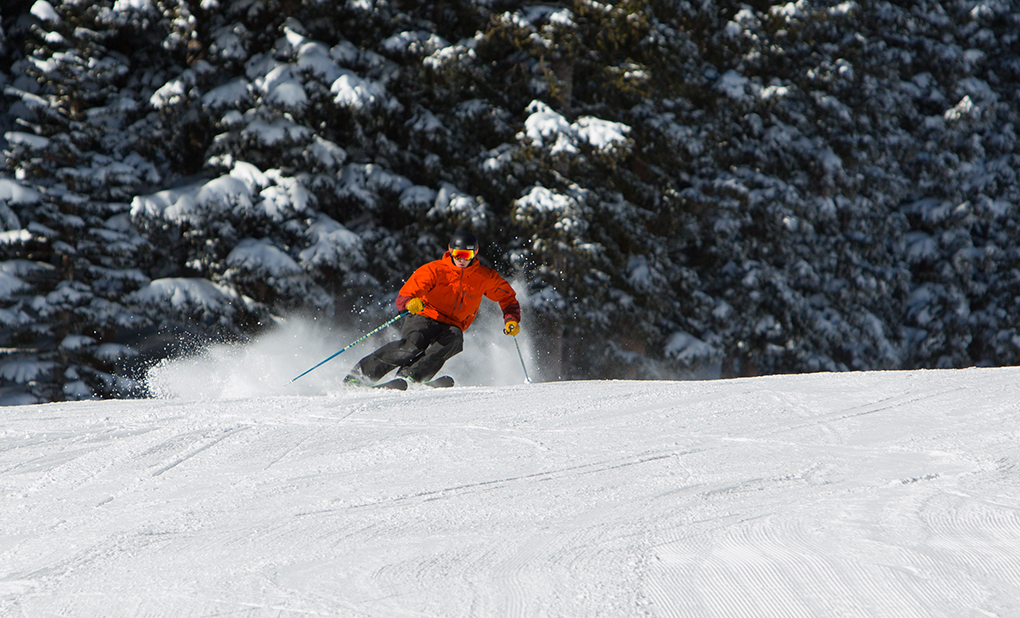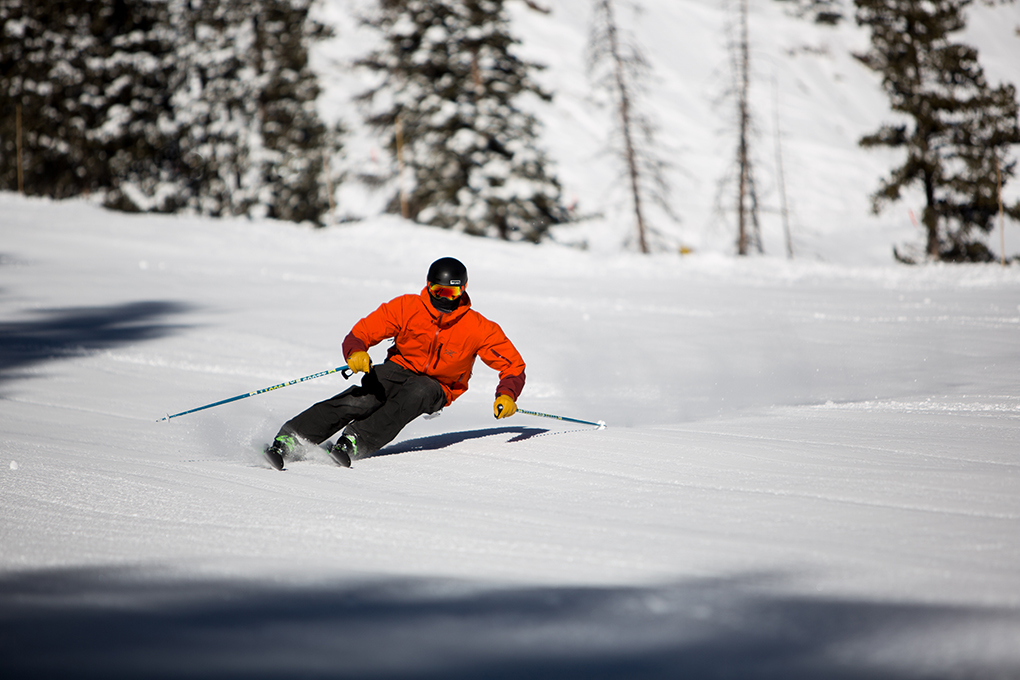
Ski: 2014-2015 Fischer Progressor 900 Black, 175cm
Stated Dimensions (mm): 121-75-104
Stated Sidecut Radius: 13-17 meters
Mount Location: Factory recommended line
Boots / Bindings: Fischer Ranger Pro 13 / RSX Z 13 RaceTrack (DIN at 10)
Test Location: Taos Ski Valley
Days Skied: 2
We’ve reviewed three freeride skis from Fischer over the past few seasons: the Big Stix 110, part of their Big Stix series of twin-tipped, tip and tail rockered skis, and the directional, flat-tailed Watea 96 and Watea 106, now called the Ranger 96 TI and Ranger 106 TI.
We’ve been pretty impressed with all of those skis in variable, off-piste conditions, but we haven’t forgotten that Fischer has a long history making race skis, too. With this in mind, we made sure to include the Progressor 900 in our frontside carver test.
The Progressor 900 is billed as the most demanding ski in Fischer’s High-Performance line, which is the most firm snow / carving-oriented group of skis apart from their Race and World Cup series.
The Progressor is heavily geared toward groomed, on-piste conditions, but it’s still not the most specialized ski we tested last week (see our review of the Ski Logik Front Burner).
Flex Pattern & Shape
The Progressor 900 is effectively a race ski that’s been made a bit more versatile, and a little more accessible.
At 75mm underfoot, the Progressor is a little wider than almost all the skis in Fischer’s Race and World Cup lines (only one of which is over 70mm underfoot), but the shape of its tip and tail are almost identical to that of the RC4 Superior RC, one of Fischer’s GS skis.
The RC4 Superior RC is a bit stiffer than the Progressor and has a less dramatic sidecut through its shovel, so it doesn’t initiate turns quite as quickly as the Progressor. The Progressor is very quick, but it is also capable of making bigger, stable carves, as I’ll say more about below.
And while it’s a little softer than the RC4, the Progressor isn’t all that soft. Its shovels have a medium/stiff flex, and its tails are a little stiffer, and inspire confidence when laying over carves.

Smooth Groomers
Much of my time on the Progressor 900 was spent on smooth, buttery groomers, and as you’d expect, the ski is very easy to tip on edge into a carve and flick from edge to edge when transitioning from one arc to the next.
Initially, I had a bit of a tough time getting a sense for how tight or how long the sidecut radius of the Progressor feels, as it seems to largely depend on how aggressively you drive the ski into a carve. This could be said of any ski, I suppose, but I was surprised by how versatile the Progressor felt with respect to how long or short I wanted a carved turn to be.
I could lay into the Progressor hard to work it through its tightest radius (which, for what it’s worth, felt something like ~16 meters), like a very quick GS ski. But at the same time, the ski still inspired some confidence when going faster, making bigger, sweeping carves, still providing extremely dependable edge hold. The Progressor definitely prefers to carve rather than smear turns, but I didn’t feel as if the ski was more-or-less “set” on one particular turn shape / radius, which is something I’m more inclined to say about another ski we’ve been reviewing, the SkiLogik Front Burner.

Fischer Progressor 900 vs. Ski Logik Front Burner
The Front Burner has a slightly tighter, more aggressive sidecut than the Progressor—which has a pretty tight sidecut radius to begin with.
Carving turns at moderate speeds, the Front Burner’s shovel felt quicker to engage and pull across the hill than the Progressor’s, and its flex is also a little softer than the Progressor’s, so the skis felt a bit easier to bend at lower speeds. And the fatter tail on the Front Burner seemed to lock it into a tight, 14-meter carve much more strictly. This made the Front Burner less stable and confidence-inspiring through longer, sweeping carves than the Progressor, where it felt a little twitchier / overly grabby at times.
But the Front Burner provides more energy when carving clean or scrubbed / skidded turns at lower speeds, where the Progressor feels a little heavier and requires a little more input. Both skis are very responsive and require you to make a technically strong turn in order to arc them cleanly and smoothly (the flat, squared-off tails on both skis don’t do much without your input), but the Front Burner feels better optimized to provide more energy through shorter carves, at lower speeds, more easily.
On the whole, the Progressor feels considerably more lively than any ski with a ~20m sidecut radius, so shorter carves back and forth across the hill feel most appropriate on it. But I did find myself more comfortable carving both short and slightly longer turns on it than the Front Burner.

Roughed-Up Groomers & Off-Piste Conditions
The Progressor 900 and the Front Burner are billed as on-piste skis, and when it comes to carving up groomers, they are both a whole lot of fun.
When groomed runs are smooth, I can’t say that one ski feels clearly better or preferable to the other; they each have a minor, but noticeably different feel with respect to the range of speeds and turn shapes they like best, as I’ve said above.
As groomers got more roughed-up and bumpier after snow got pushed around and consolidated, the Progressor’s slightly heavier construction, stiffer flex, straighter shape, and lightly rockered tip made it feel a little more capable. At speed, I felt more confident carving turns over firm ridges and bumpy sections on the Progressor than I did on the Front Burner. I’m probably splitting hairs here, as neither ski feels at home in anything approaching what you might call off-piste conditions, and neither Fischer nor SkiLogik say they’re supposed to. Both seemed to get kicked around by light, cruddy snow pretty easily and, predictably, didn’t provide any real float or track in ~3-4” of soft chop.
If you are looking for a ski that provides strong on-piste performance but can also handle some off-piste, variable conditions, then I think you’re better off considering skis that fall into more of an “all-mountain class” than the ‘frontside class” where the Progressor and Front Burner both reside. Take a look at Jonathan’s review of the Salomon X-Drive 8.0 FS, for example, and keep an eye out for our review of the Fischer Motive 86 TI.
Bottom Line
If you like the sound of a powerful, responsive ski for making aggressive, high-angle carves on groomers, I think you’ll like the Fischer Progressor 900. Strong, advanced, and expert skiers will really enjoy its firm flex, stability through a variety of turn shapes, and great edge hold.
And if responsiveness during snappy, tight carves is your sole, specific priority, I’d stay tuned for our review of the SkiLogik Front Burner.

Dear Will:When are you guys going to review the Nordica NRGy 100’s?Thanks
Hey Bo,
We’re working on getting a pair to test right now. If all goes well, we should be on them in early February.
Thanks,
Will
Miss having my kids race on these radius skis. They are on FIS skis now 30 and 35 meter GS skis that require a shivit turn.
I am glad you guys are reviewing skis that work on those boiler plate groomer days because pow is a luxury for most of us. I am interested in the Rossi Hero Master R-20 and the Dynastar Speed Premium Master R-20 (actually the same ski but different paint job), and am hoping that you can do a racer review on these two beer league weapons. I am looking for a racer for Master`s competition as well as fast free skiing obviously on hard corduroy days. Some of my ski buddies are on Volkl Race Tigers and Head`s Fis skis but these although superior in the course are not great for free sking in anything other than early morn open conditions before you have to start dodging the masses. I guess I`m looking for race versatility (if there is such a thing).
Wow, I own the Progressor 900 and your review is spot on. Nice job. I’ll be following more of your reviews.